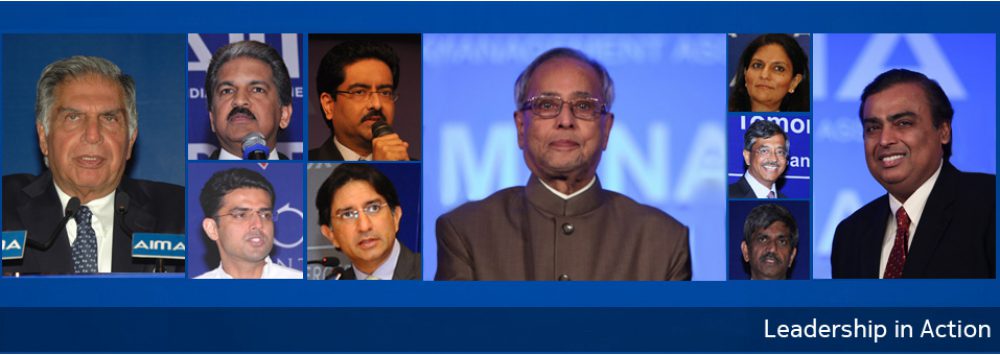AIMA organised an International Conference on the theme “Building Human Capital for the Knowledge Economy“, on 15th March 2016 in Dubai, United Arab Emirates. The conference brought together policy makers, CEOs, thought leaders, from both India and UAE to discuss strategies to promote cooperation between the two countries.
Below is an excerpt from the speech of Mr Pramod Bhasin, Founder, Genpact and Chairman, The Skills Academy on Human Capital Competitiveness: Creating Excellence in Education and Training

Pramod Bhasin, Founder, Genpact and Chairman, The Skills Academy addressing the conference
We are, as a country the most attractive destination in the world today for investment and opportunity. 8.4% average annual growth rate over the last so many years is a phenomenal achievement and; while we sitting inside India are the worst critics of India, I think sometimes when we step outside, we forget to understand how the rest of the world looks like and I think we have an enormous opportunity. When I was building Genpact which was really the pioneer and it was my idea and we, as a result, created the BPO industry, the first thing that struck us was the lack of skilled available people and the fact that only 6-9% of our graduates are truly employable.
No matter which company you talk about be it Infosys, TCS, or Genpact, we all have huge training capabilities to supplement what has been taught in our colleges and our educational institutions across the world. So education has been a very difficult topic and I believe education and skill development in India has failed the middle classes and has certainly failed the bottom of the pyramid. Both in terms of providing them skills that are useful for employability as well as training people to think about skills as a career. If you look at the statistics, they are really quite strange.
We have 250 million people in the employable area at a very young age and demographics. We have nearly 7 million people joining the workforce, the employability workforce, every year. Only 5-8% of our entire employment is in the organized sector. The rest is in an unorganized sector so whenever we talk about what we are doing for companies or people, we forget that 90% of the population is actually being left out completely from its calculations and thought. So education and skills remain a very emotive subject and a very difficult one to grasp. There are many issues but I don’t want to go only to issues because I want to talk about opportunity. There are many issues today like awareness of skills and the values of skills; who will pay for skills training is still an open question frankly. Even though the current government has done an enormous amount to push it forward, we still need to train 50 million people up in vocational skills. Who is going to pay for this? The quality of the training, is it good enough? Are we producing people who are really employable in industry immediately the day they step in? Who will build, who will train the trainers? We just don’t have enough trainers, not just in India, but across the world if you look around. The crying need is who is going to train the trainers. We also have to completely change our model, we have to substantially change the way we skill people. For instance, we can’t take Singapore’s model or Germany’s model and plant them in India. It won’t work. I will give you some examples, we train in the skill academy, an institution set up three years ago mainly to focus on school and college dropouts in rural semi-urban India We are in the villages of Bihar, Orissa, UP, Rajasthan, Madhya Pradesh and in the Dharavi slum of Mumbai, but let me give you a very quick example of things that we fail at.
Firstly, When we walk into these villages with our training, it’s virtually free or funded by the Government and we expect a line of people outside the door waiting to get trained. Wrong. We actually have to work with the government to get them there to say ‘please get trained’ and during the course of these skills training, 50% of the people drop out, for a variety of very good reasons; they need to work they are not sure about the outcome, if this will allow them to do other things or get a better job or get a step on the ladder. For instance, the testing that we do is very interesting and in Dharavi we were training people and kids who are between the ages of 18 to 24. When we put them in front of a computer and asked them to do a math test or arithmetic, they fail. Yet that same person will go out on his stall to sell goods and is negotiating fluently, he is doing the maths in his head and is way ahead of what my own children would ever be at that age, in terms of understanding mathematics, negotiations,and communication skills; but the moment we put a computer in front of them they freeze. They are unfamiliar with that territory. They don’t know how to respond to it and therefore the way we train people and what we train them for has to change quite dramatically.
As we think about adapting to India, I really believe we need a new approach. One: we must leapfrog, we don’t have to go through trying the old existing models. We have to get the benefit of technology, grab hold of opportunities, and the way people are doing distance learning; massive open courses (MOOCS). Finding ways to reach out to students across India, we have to train 50 million not 10,000. That is the enormity of the problem that we face.
Two: we have to learn across the board to make our curriculums relevant. Too often caught up in the entire process of training, curriculums are becoming irrelevant to the industry for which they are being trained. Consequently, while we may have many ITIs in many technologies, many institutions for vocational skills, and their relevance becomes poor.
Three: we must allow innovation and creativity and experimentation so we must be model agnostic. At this point of time, most countries around the world demand a certain amount of face-to-face training and classrooms etc. But when online and broadband shows up and we know we will have the largest broadband network in the world in a few years. Why can’t we use that and be agnostic to the models that we are using because we focus on outputs and what people have learned rather than focusing on how it’s being delivered or the technology behind the delivery. We must lastly focus enormously on outputs. Too much of our skills training and education is focused on input. What is the curriculum, what you are training them for, what do they need; and not enough is focused on what do they already know and how do we take that to enhance and make it practically far more interesting.
All of this: the lack of skilling, the lack of vacation represents a massive opportunity that I hope we will grab with both hands. Our partnership with UAE can be enormous to train trainers. By the way, one of the few successful models that exist in India for vocational skill training is of training people for export into the UAE. Those are the models where people are willing to pay a lot of money because they know that the benefit they will get as a result of being exported are enormous and the job opportunities that will get are enormous. But we could do technologies training, teacher training, we could build on a wide variety of skills that are used in the UAE and which are also very relevant when they bring them back home. This already applies to nursing, it can apply to construction, the tourism industry , and to services across the board . There are great problems that we need to solve in the skilling and the education of the skills. We have to recognize what do people who are already in the workforce, what sort of training do they need. I know that many people assume that once you have been trained and got a certificate, it’s over but it’s not as you move up the chain, unless industries continue to allow these programs to evolve, you are not going to deliver the results you want nor people going to see the value that arises in skills nor will they be able to see how much of a difference it has made to the quality of their lives.
We must learn how to build, for instance, apps. Can you imagine if three million people in India could build apps for the entire world? Can you imagine the power that we would have? This will take a long time but it will not take as long as we think. If we can provide technology training you can learn how to build an app, in 3-4 weeks if you have some basic training. You can learn how to build an app so can you imagine the power of that demographic dividend of all these people focusing on technology and technology breakthroughs in a whole variety of area it could be in agriculture, health care, training etc. Can you imagine for instance partnering with countries such as UAE, in which you can build a partnership whereby we can train people in specialized sectors? Can we train them in healthcare? we must allow that to evolve into an educational sphere. Can we imagine how we can allow ease of doing business? It’s so easy to do business here which is why you get so much investment into these areas. Can we imagine how we can use that ease of doing business to allow experimentation in the model behind skill development? You know, when I started down this journey about three years ago, I was in despair because our skills academy, loses lots of money every month but we will try and correct that as we go forward at some point in time. I hope I will see the light at the end of the tunnel. I was in despair at that time but now with all the frameworks that the government has introduced, it is doing some amazing stuff which I love. It is pushing for higher and higher quality of training providers for the things that they are trying to put in terms of funding opportunities for training providers for skill sector, for qualification of people in the curriculum that they are putting out. We are making actually very major strides. I suspect I have not checked that the progress that we have made in the last 5 years is the same progress that perhaps many other countries might have made in 15 years over the course of time but we have grabbed some of these benefits and brought them in. We still need to learn how to be innovative and creative but I hope that’s where the real success of this model will lie and it will allow us all to train the next 40 million people which is really what we need to be able to achieve. Thank you very much!
Watch full video here:



